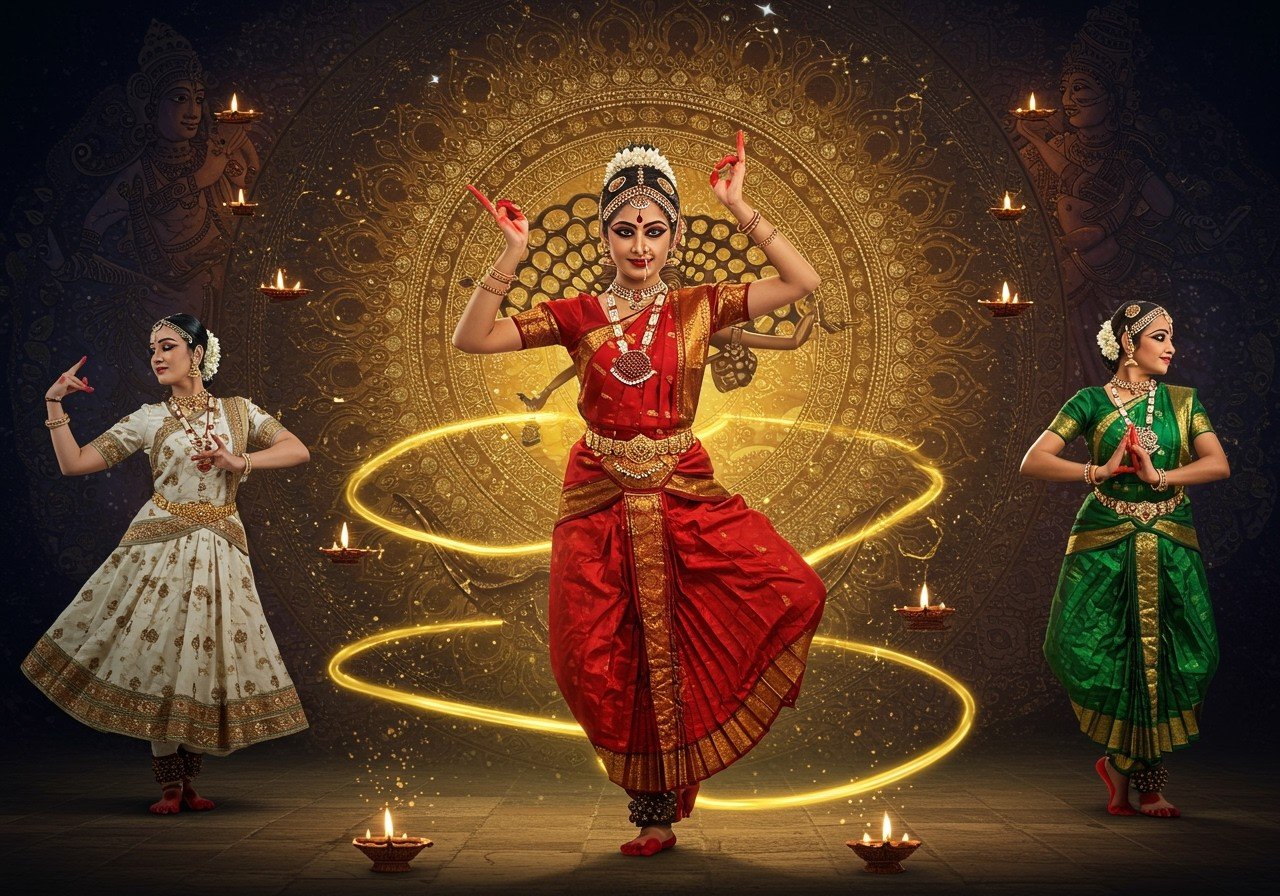
Indian Classical Dance is a captivating and intricate art form deeply woven into the cultural fabric of India. More than mere performances, these dances serve as a powerful medium for storytelling, emotional expression, and the celebration of ancient traditions. Each style boasts a unique history and set of techniques, contributing to the rich tapestry of India’s cultural heritage. As individuals increasingly seek to reconnect with their roots, Indian Classical Dance is experiencing a resurgence of interest.
History and Evolution
Origins and Growth: Indian Classical Dance’s origins can be traced back to the Natya Shastra, an ancient treatise on performing arts. This text established the groundwork for various dance forms. Through the ages, these dances have undergone transformations, shaped by historical events and cultural exchanges. Royal patronage and temples played a crucial role in safeguarding these traditions.
In the 20th century, revitalization efforts propelled these classical forms onto the global stage. Key figures and gurus have dedicated themselves to teaching and developing these dances, ensuring their enduring relevance.
Styles of Indian Classical Dance
Eight recognized styles constitute Indian Classical Dance, each possessing a distinct allure and historical narrative.
Bharatanatyam
Originating in Tamil Nadu, Bharatanatyam is celebrated for its intricate footwork and expressive hand gestures. Often performed in temples, it’s a dance of devotion. The dancers’ vibrant costumes, typically pleated sarees and ornate jewelry, accentuate every movement. Beginners often start with “Alarippu,” a graceful warm-up dance introducing fundamental steps. Those interested in learning more about Bharatanatyam might find appropriate products on Poojn.in.
Kathak
Hailing from Northern India, Kathak is renowned for its narrative style, conveying stories through movement. This form artfully blends elegance and expression, influenced by Persian and Mughal cultures. Performers wear traditional attire, often including ankle bells that create rhythmic sounds. Beginners concentrate on footwork, hand movements, and graceful expressions.
Kathakali
Kathakali, a dance-drama from Kerala, is characterized by elaborate makeup and costumes. Performers skillfully use facial expressions to depict stories from Indian epics. This demanding style necessitates dedication to mastering dramatic expressions and movements. Training involves a deep understanding of the characters and performing with intensity.
Kuchipudi
Kuchipudi, originating from Andhra Pradesh, combines dance and drama, with performers narrating stories through expressive gestures and speech. Elegant costumes and jewelry complement the performance. Learning begins with basic footwork, hand gestures, and postures, progressing to more complex compositions.
Odissi
From Odisha, Odissi is known for its fluid movements and sculpturesque poses. It often depicts stories of love and devotion, inspired by temple sculptures. Vibrant costumes and silver jewelry adorn the performers. Students begin with basic steps and postures, focusing on rhythm and grace.
Manipuri
Manipuri, from the northeastern state of Manipur, is a devotional dance characterized by graceful movements and gentle expressions. Performers wear traditional costumes with beautiful jewelry. Beginners learn basic footwork and hand gestures, gradually advancing to more intricate sequences.
Mohiniyattam
Also from Kerala, Mohiniyattam is a dance of enchantment, featuring graceful movements and subtle expressions. The attire includes a white saree with gold borders and traditional jewelry. Students concentrate on gentle footwork and hand gestures, with an emphasis on elegance.
Sattriya
Sattriya, from Assam, is rooted in devotion to Lord Krishna. It features storytelling through graceful movements and expressions. Performers wear traditional attire in vibrant colors. Beginners start with foundational steps, focusing on rhythm and storytelling.
Learning Indian Classical Dance
Embarking on a journey to learn Indian Classical Dance is a richly rewarding experience. Begin by selecting a style that resonates with your interests and cultural background. A qualified guru is essential for authentic training. A typical class begins with warm-up routines, followed by instruction in basic postures, footwork, and hand gestures. Consistent practice is paramount to mastery.
Online resources have expanded access to learning, with platforms offering virtual classes at various levels, connecting learners with experienced instructors worldwide. Check out Poojn.in’s articles for more insights into Indian culture and arts. They might also offer essential items for your dance practice.
Benefits of Learning Indian Classical Dance
Learning Indian Classical Dance offers a multitude of advantages:
- Physical Fitness: The demanding postures and movements enhance physical fitness and stamina. Regular practice builds strength and flexibility, contributing to overall well-being.
- Mental Benefits: The focus required improves concentration, discipline, and memory. Learning complex sequences and rhythms sharpens cognitive skills and enhances mental agility.
- Emotional Well-being: Dance provides an avenue for self-expression and stress relief. The rhythmic movements and expressive gestures can be cathartic, promoting emotional balance and well-being.
- Cultural Understanding: Learning a classical dance form deepens knowledge and appreciation of Indian heritage and traditions. It fosters a connection to the rich history and cultural narratives embedded within these art forms. Explore traditional puja items related to dance at Poojn.in.
- Community Connection: Engaging in dance fosters a sense of community and belonging among practitioners. Sharing the learning experience and performing together creates bonds and fosters a supportive environment. Find beautiful statues of deities at Poojn.in, which can inspire your dance journey.
Embracing this art form enriches life physically, mentally, and culturally.
Beginning Your Dance Journey
Starting Indian classical dance as a beginner is entirely possible. The structured approach cultivates essential skills: hand-eye-leg coordination, body control, and core strength. While demanding patience and endurance, it’s a rewarding experience.
Understanding the Basics
- Starting Point:Initial instruction emphasizes basic footwork, hand movements (mudras), and postures. Gradually, you’ll learn more complex compositions and sequences. Regular practice is crucial for developing muscle memory and precision.
- Adavus:These are the fundamental steps. They combine hand gestures, leg movements, and postures. Mastering these foundational elements is crucial for progressing to more intricate combinations and expressive movements. Their precise execution forms the basis of the dance.
- Mudras:These symbolic hand gestures convey specific meanings. Integral to storytelling in dance, they add layers of meaning and expression to the performance, allowing dancers to communicate narratives and emotions non-verbally. Poojn.in offers a variety of items that can enhance your spiritual practice while you learn these intricate movements.
Popular Dance Forms for Beginners
- Bharatanatyam: This ancient dance form from Tamil Nadu is characterized by intricate footwork, expressive hand gestures, and a strong rhythmic base. Beginners often start with “Alarippu,” a warm-up dance. Essential elements include Tatta Adavu (basic stamping step), Natta Adavu, Hasta Mudras, and basic neck movements. Mastering standing positions like Sampada and Natyarambha is also crucial. You can find items related to Bharatanatyam on Poojn.in.
- Kathak: This North Indian dance form emphasizes storytelling through movement and intricate footwork, often accompanied by rhythmic sounds from ankle bells. Beginners learn basic footwork, hand movements, and postures, with a focus on Abhinaya (expressions), grace, and elegance. Poojn.in can provide you with essential puja items to enhance your dance practice.
Learning Tips for Beginners
- Qualified Instruction: Learning under a qualified instructor ensures accurate technique and provides personalized guidance. Many online and in-person classes cater specifically to beginners. A skilled instructor can correct posture, refine movements, and provide valuable feedback for improvement. They can also suggest appropriate resources from Poojn.in to aid your practice.
- Regular Practice: Consistent practice is key to improving technique and mastering movements. Focus on maintaining correct posture, a straight back, and a steady stance. Regularity builds muscle memory and enhances flexibility and stamina, essential for complex dance sequences. Consider creating a dedicated practice space with appropriate items from Poojn.in.
- Grace: Prioritize executing moves with grace and fluidity. Grace adds an aesthetic dimension to the dance, enhancing its visual appeal and expressiveness. It involves coordinating movements seamlessly and conveying emotions through elegant gestures. Enhance your practice space with inspiring items from Poojn.in.
- Dedicated Space: Creating a well-lit, distraction-free space with a non-slip floor promotes focused practice and helps prevent injuries. This dedicated space becomes a sanctuary for learning and honing skills. You might find helpful items for your space on Poojn.in.
Embark on this enriching journey of cultural discovery and personal growth through Indian Classical Dance.


